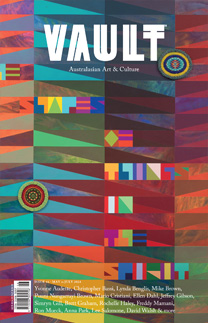Michael Cook
The Skins We Live In
Michael Cook’s arresting compositions subvert colonial hierarchies and reclaim the nostalgic half-experiences that are too painful to forget.
I recently came across the Welsh word hiraeth which describes the nostalgia one feels for the lost places in their past and the yearning for an experience that never was. The ethereal and otherworldly works of Michael Cook align with such feelings. Imagine an alternative scenario in which light and dark skins are swapped, roles and hierarchies are reversed, and conqueror and conquered become interchangeable.
In a bustling Brisbane restaurant, over a snail-paced lunch of chicken and greens, Cook and I discuss the forces that led him to use art as a vehicle for discovering his Aboriginal identity and to cast a contemporary spin on the historical and socio-political experiences of Indigenous Australians.
Cook’s own story began in the late 1960s in a small rural Queensland community. An unmarried white woman, all of sixteen, fell pregnant to an Aboriginal man and fled to a hospital to give birth to a boy she could not keep. “It was pretty conservative back then,” Cook tells me. “Young pregnant women in these situations were expected to offer their baby up for adoption.” As a parting gift, the teen named her newborn Michael and three weeks later, he was adopted into a white family in Hervey Bay. His adoptive mother was a local counsellor and political activist who fought for the rights of Indigenous Australians.
“My mother gave me a good understanding of my Aboriginal heritage” recalls the artist, who hails from the Bidjara people of southwest Queensland. “She also introduced me to Neville Bonner (the first Indigenous Australian to become ... Subscribe to read this article in full
























